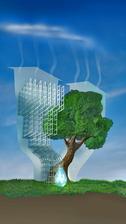Sketch of a nanoporous material made of silicate nanopores placed next to a tree to show the comparison between water movement in a tree and the porous material used in the experiment. (Credit: DESY/TUHH)
An astonishing property of trees is their ability to transport water and dissolved nutrients from their roots all the way up to their crowns, sometimes dozens of metres above, without the need for a mechanical pump. The underlying mechanism is ingenious: trees have a system of fine capillaries through which the water can rise from below the ground to the very tips of their branches. This transport process is driven by the evaporation of water from small pores in the leaves. Capillary forces and the small size of the pores lead to enormous negative pressures, which suck the water out of the soil and draw it upwards against the pull of gravity.
A team led by Patrick Huber, a researcher at DESY and professor at the Hamburg University of Technology (TUHH), has been investigating the details of this mechanism. However, rather than studying actual trees, the scientists instead focused on a special type of nanomaterial – a silicate glass permeated by innumerable, extremely fine pores. The nanoporous glass was positioned so that water could enter it from below and rise up inside. “Once the liquid had infiltrated it, the transparency of the glass changed,” explains first author Juan Sanchez. “We could see the liquid rising with the naked eye.” An extremely sensitive force gauge measured how the glass cylinder, with a height of just over one centimetre, reacted as the water infiltrated it and how its length changed.
“We were in fact expecting the sample to shrink a little because as the water rises, the drop in pressure produced by the evaporation should affect an increasingly larger region of the glass,” explains Huber. “But we were in for a surprise: the glass rod actually expanded, ultimately by a thousandth of its original length.” At first, the team suspected an error in its measurements, but the effect persisted in further experiments: Instead of contracting, the nanoporous glass was expanding.
Eventually, the team hit upon the explanation: as the nanopores in the silicate glass fill up with water, the surface stresses exerted on the pore walls decrease – causing the pores to expand. “This effect is more pronounced than the contraction caused by the negative pressure due to evaporation,” explains Huber. “That’s why, overall, we measured an expansion of the glass sample.” This was confirmed by the work of Huber’s colleague Lars Damann, co-supervised by Robert Meißner, professor at the TUHH and researcher at the Helmholtz Centre Hereon. Damann modelled the phenomenon using computer simulations and arrived at very similar results. The pressure inside the nanoporous material is reduced considerably: An artificial tree made of such a material could transport water to the height of several hundred metres – much higher than the tallest redwood.
These findings could open the door to exciting new applications. “Our method could be used to determine the extent to which a nanoporous material is filled with liquid, simply by measuring its length,” explains Huber. “This would be particularly interesting for opaque materials, such as battery electrodes containing carbon.” Conceivably, a sensor could be built to monitor the electrolyte level in a battery – which is relevant for the batteries used in electric cars, for example, as well as the supercapacitors that are used to recover energy during regenerative braking. Similar effects could be utilised for filter membranes, as well as nanoporous materials that could serve as a future source of energy by alternately allowing them to become wet and dry as the tide ebbs and flows.
The new technique may also be suitable for detectors that measure humidity with very high precision. The group is already exploring these ideas: “We are currently extending our work to other materials, such as nanoporous carbon,” explains Sanchez. “In this case, we not only allow pure water to infiltrate our samples, but also electrolytes such as those used in batteries.”
The team consisted of researchers from DESY, the Hamburg University of Technology, the Helmholtz Centre Hereon, Michael Fröba from the University of Hamburg, and Howard Stone from Princeton University in the USA. The computer simulations were carried out as part of the Helmholtz graduate school DASHH, and the experiments were embedded in the DFG Research Training Group GRK 2462 “Processes in Natural and Technical Particle-Fluid Systems (PintPFS)”.
(from DESY News)
Reference:
Deformation dynamics of nanopores upon water imbibition, Juan Sanchez, Lars Dammann, Laura Gallardo, Zhuoqing Lia, Michael Fröba, Robert H. Meißner, Howard A. Stone, Patrick Huber, PNAS, 2024, DOI: 10.1073/pnas.2318386121







